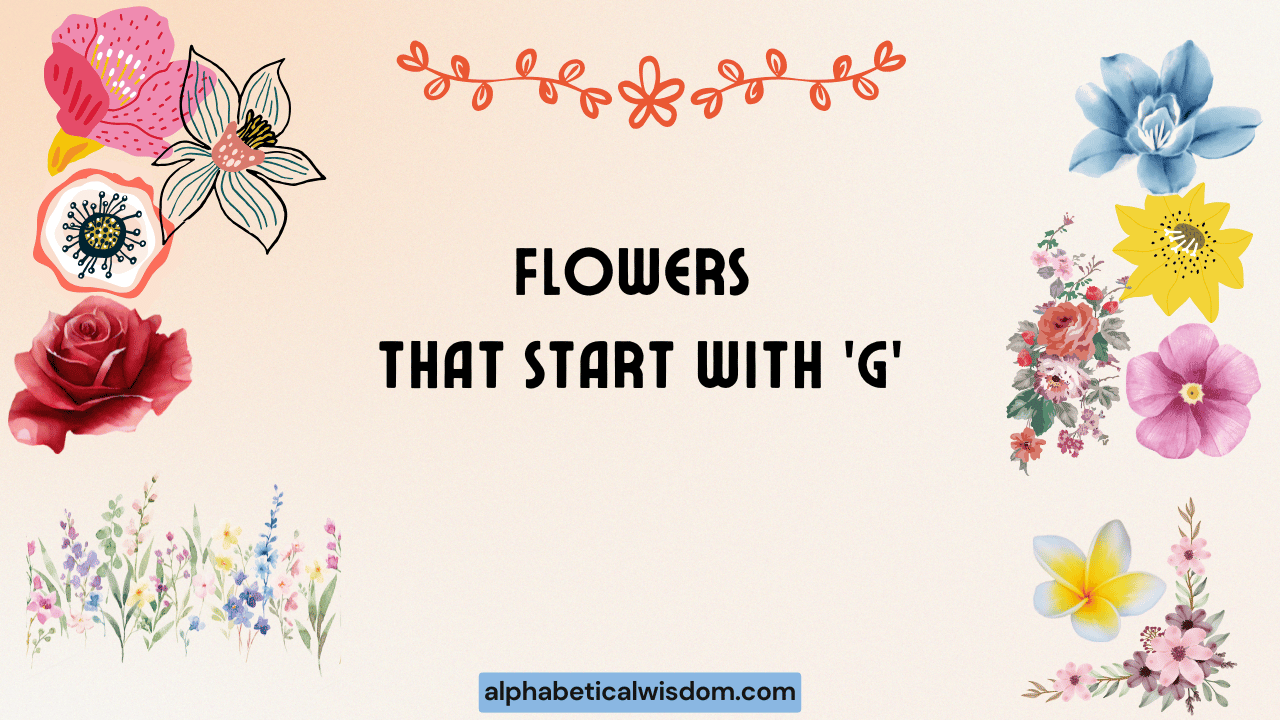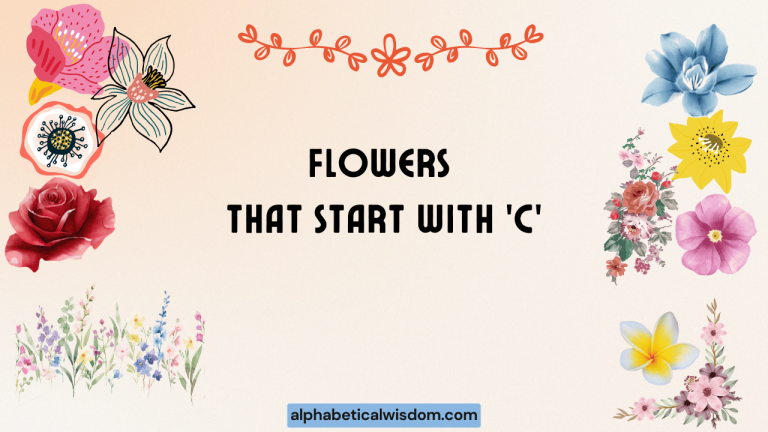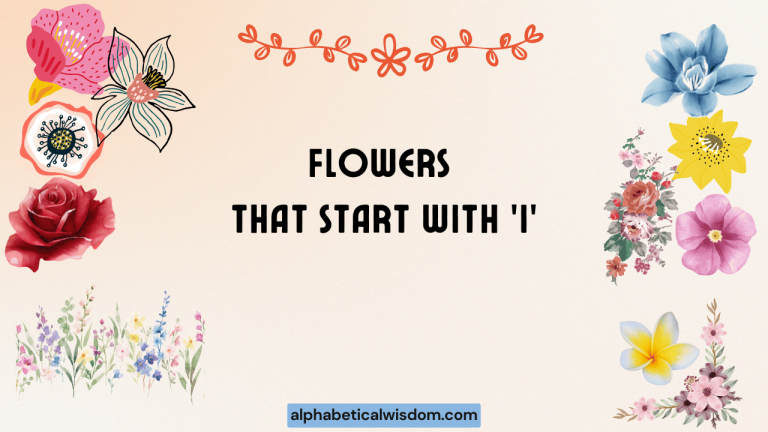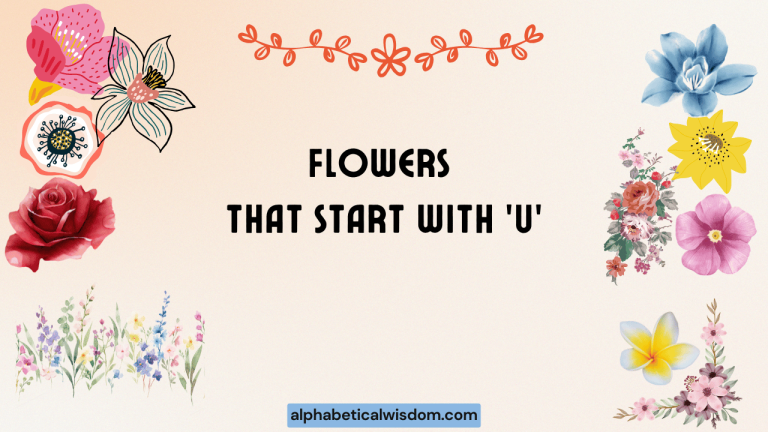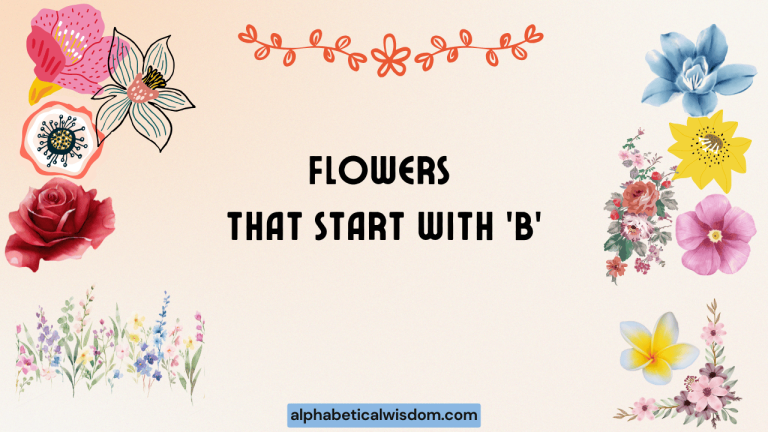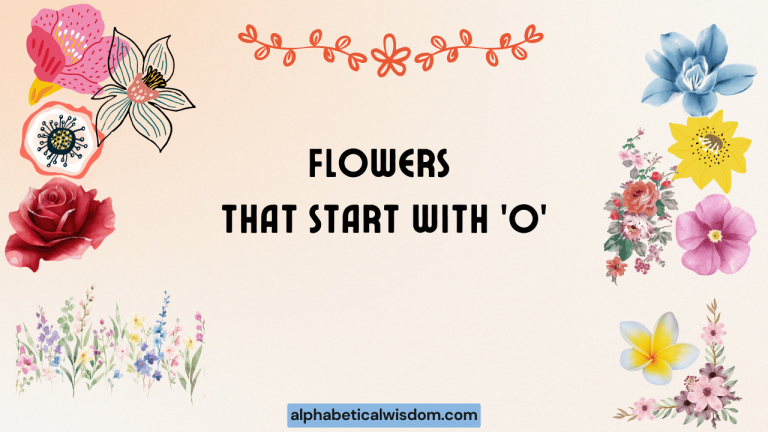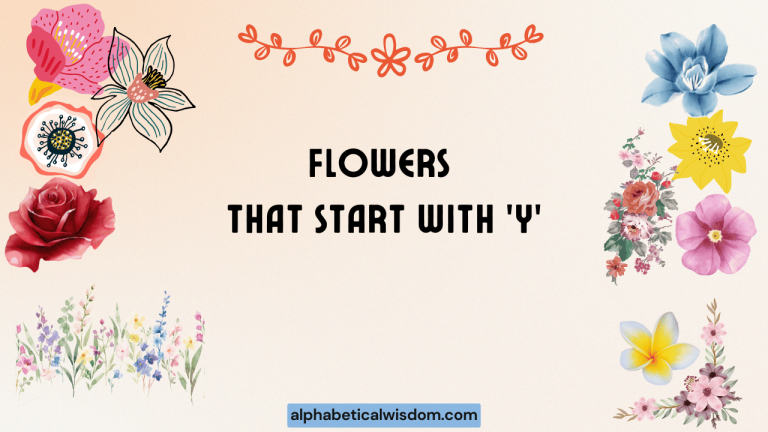Flowers That Start With “G”: A Grammatical Exploration
Understanding nouns, specifically those referring to flowers, is crucial for building a rich vocabulary and mastering English grammar. This article focuses on flowers whose names begin with the letter “G,” exploring their grammatical properties, usage, and common mistakes.
Whether you’re a student, a language enthusiast, or simply curious about flowers, this guide will enhance your understanding of nouns and their role in crafting clear and accurate sentences. We will delve into singular and plural forms, countable and uncountable nouns, and how these floral nouns function within various sentence structures.
Table of Contents
- Introduction
- Definition of Nouns and Flower Names
- Structural Breakdown of Floral Nouns
- Types and Categories of “G” Flowers
- Examples of “G” Flowers in Sentences
- Usage Rules for Floral Nouns
- Common Mistakes When Using Floral Nouns
- Practice Exercises
- Advanced Topics: Figurative Language and Idioms
- Frequently Asked Questions
- Conclusion
Definition of Nouns and Flower Names
A noun is a word that represents a person, place, thing, or idea. Nouns are fundamental building blocks of sentences, serving as subjects, objects, complements, and more. Flower names, such as gardenia or gladiolus, fall under the category of common nouns (unless referring to a specific cultivar, in which case they might be proper nouns – e.g., ‘Golden Celebration’ rose). Understanding the difference between countable and uncountable nouns is essential for correct usage. Countable nouns can be singular or plural, while uncountable nouns typically do not have a plural form.
Flower names typically function as common nouns, referring to a general type of flower rather than a specific instance. For example, “gardenia” refers to any flower belonging to the Gardenia genus. However, when referring to a particular variety, such as “Gardenia ‘August Beauty’,” it can be considered a proper noun, requiring capitalization. The context of the sentence usually clarifies whether a flower name is being used as a common or proper noun.
Structural Breakdown of Floral Nouns
Floral nouns, like all nouns, can be examined for their morphological structure. Many flower names are derived from Latin or Greek roots, often describing a characteristic of the plant.
For example, “gladiolus” comes from the Latin word “gladius,” meaning sword, referring to the shape of the leaves. Understanding these roots can aid in memorization and comprehension.
Furthermore, floral nouns can be modified by adjectives to provide more specific descriptions, such as “fragrant gardenia” or “tall gladiolus.” These adjectives add detail and enhance the imagery within a sentence.
The grammatical gender of floral nouns is usually neutral, meaning they typically don’t have a specific gender associated with them in English. However, in languages like French or Spanish, nouns have grammatical gender, which can influence the articles and adjectives used with them.
The structure of a sentence containing a floral noun follows standard English syntax: Subject-Verb-Object. The floral noun can occupy any of these positions depending on the intended meaning.
Types and Categories of “G” Flowers
Flowers that start with “G” encompass a diverse range of species, each with unique characteristics and classifications. These can be categorized based on various factors, including botanical family, color, fragrance, and growing conditions.
Understanding these categories can help in selecting the right flowers for specific purposes, such as gardening, floral arrangements, or medicinal uses.
Common “G” Flowers
This category includes the most frequently encountered flowers starting with “G.” These flowers are often cultivated in gardens and used in bouquets.
- Gardenia: Known for its strong, sweet fragrance and creamy white petals.
- Gladiolus: Characterized by its tall, sword-like leaves and vibrant, colorful flowers arranged along a spike.
- Geranium: A popular flowering plant with a wide range of colors and growth habits.
- Gazania: Daisy-like flowers that open in sunlight and come in bright colors.
- Gloriosa Lily: Also known as flame lily, known for its exotic, reflexed petals.
Less Common “G” Flowers
This category includes flowers that are less widely known or cultivated, often found in specialized gardens or natural habitats.
- Gilia: A genus of flowering plants native to North America, often with delicate, tubular flowers.
- Gomphrena: Also known as globe amaranth, featuring球形花序 and colorful bracts.
- Grevillea: Native to Australia, known for its unusual, spider-like flowers.
- Gaillardia: Also known as blanket flower, known for its daisy-like flowers with warm colors.
- Gentian: Often blue, trumpet-shaped flowers found in alpine regions.
Categorization by Color
Floral nouns can also be categorized by their predominant color. This is useful for creating visually appealing arrangements or designing gardens with specific color schemes.
- White “G” Flowers: Gardenia, some varieties of Geranium.
- Red “G” Flowers: Some varieties of Geranium, Gladiolus.
- Yellow “G” Flowers: Gazania, Gaillardia.
- Blue “G” Flowers: Gentian.
- Orange “G” Flowers: Gaillardia, Gazania.
Examples of “G” Flowers in Sentences
The following tables provide examples of how “G” flower names can be used in sentences, demonstrating their function as nouns in various grammatical contexts. These examples cover singular and plural forms, as well as different sentence structures.
Gardenia Examples
This table illustrates the usage of “gardenia” in various sentence structures, showcasing its role as a noun in different contexts. Note the use of singular and plural forms.
| Sentence | Grammatical Function |
|---|---|
| The gardenia is known for its intoxicating fragrance. | Subject |
| She received a beautiful gardenia as a gift. | Object of the verb |
| The scent of the gardenia filled the room. | Object of the preposition |
| Gardenias are often used in wedding bouquets. | Subject (plural) |
| He prefers gardenias over roses. | Object of the verb (plural) |
| The bride’s hair was adorned with a single gardenia. | Object of the preposition |
| Growing gardenias can be challenging in colder climates. | Gerund as subject |
| That flower is a gardenia. | Subject Complement |
| The beauty of the gardenia is undeniable. | Subject |
| She carefully watered the gardenia in her garden. | Object of the verb |
| The gardenia bush was full of blossoms. | Subject |
| He gave her a gardenia for her birthday. | Indirect object |
| The white gardenia stood out among the other flowers. | Subject |
| She loves the smell of gardenias. | Object of the verb |
| Gardenias thrive in acidic soil. | Subject |
| The florist recommended gardenias for the arrangement. | Object of the verb |
| The gardenia is a symbol of purity. | Subject |
| She planted a gardenia near the window. | Object of the verb |
| The gardenia‘s petals were soft and delicate. | Subject |
| He admired the gardenia in her lapel. | Object of the preposition |
| The garden was filled with gardenias. | Object of the preposition |
| She picked some gardenias from the bush. | Object of the verb |
| The room smelled strongly of gardenias. | Object of the preposition |
Gladiolus Examples
This table illustrates the usage of “gladiolus” in various sentence structures, showcasing its role as a noun in different contexts. Note the use of singular and plural forms.
| Sentence | Grammatical Function |
|---|---|
| The gladiolus stands tall in the vase. | Subject |
| He brought a bunch of gladioli to the party. | Object of the preposition (plural) |
| Gladioli are known for their striking colors and vertical growth. | Subject (plural) |
| She chose gladioli for their dramatic appearance. | Object of the verb (plural) |
| The farmer cultivates gladioli for the flower market. | Object of the verb (plural) |
| A single gladiolus can add elegance to any room. | Subject |
| The gardener planted several gladiolus bulbs. | Object of the verb |
| The gladiolus is often called the sword lily. | Subject |
| She arranged the gladiolus in a tall vase. | Object of the verb |
| The gladiolus flower bloomed in vibrant colors. | Subject |
| The gladioli swayed gently in the breeze. | Subject |
| He cut the gladioli from his garden. | Object of the verb |
| The gladiolus looked beautiful in the bouquet. | Subject |
| She bought gladioli for their height and color. | Object of the verb |
| Gladioli need well-drained soil to thrive. | Subject |
| The florist recommended gladioli for their longevity. | Object of the verb |
| The gladiolus symbolizes strength and integrity. | Subject |
| She grew a gladiolus in her backyard. | Object of the verb |
| The gladiolus‘s petals were velvety soft. | Subject |
| He admired the gladiolus in her garden. | Object of the preposition |
| The field was filled with gladioli. | Object of the preposition |
| She picked some gladioli for the table. | Object of the verb |
| The room was decorated with gladioli. | Object of the preposition |
Geranium Examples
This table illustrates the usage of “geranium” in various sentence structures, showcasing its role as a noun in different contexts. Note the use of singular and plural forms.
| Sentence | Grammatical Function |
|---|---|
| The geranium is a popular choice for window boxes. | Subject |
| She planted several geraniums in her garden. | Object of the verb (plural) |
| Geraniums are known for their vibrant colors and ease of care. | Subject (plural) |
| He prefers geraniums because they attract butterflies. | Object of the verb (plural) |
| The aroma of the geranium filled the air. | Subject |
| A red geranium brightened up the windowsill. | Subject |
| The gardener added geraniums to the flower bed. | Object of the verb |
| The geranium is easy to grow from cuttings. | Subject |
| She watered the geranium on the balcony. | Object of the verb |
| The geranium plant bloomed profusely. | Subject |
| The geraniums added color to the patio. | Subject |
| He trimmed the geraniums regularly. | Object of the verb |
| The geranium looked lovely in the pot. | Subject |
| She bought geraniums for their bright flowers. | Object of the verb |
| Geraniums are often used in hanging baskets. | Subject |
| The florist recommended geraniums for their hardiness. | Object of the verb |
| The geranium symbolizes friendship and happiness. | Subject |
| She potted a geranium for her friend. | Object of the verb |
| The geranium‘s leaves were slightly scented. | Subject |
| He admired the geranium on her desk. | Object of the preposition |
| The garden was full of geraniums. | Object of the preposition |
| She picked some geraniums for the vase. | Object of the verb |
| The room was decorated with geraniums. | Object of the preposition |
Gazania Examples
This table illustrates the usage of “gazania” in various sentence structures, showcasing its role as a noun in different contexts. Note the use of singular and plural forms.
| Sentence | Grammatical Function |
|---|---|
| The gazania closes its petals at night. | Subject |
| She planted several gazanias along the border. | Object of the verb (plural) |
| Gazanias are known for their bright, daisy-like flowers. | Subject (plural) |
| He loves the gazanias because they are drought-tolerant. | Object of the verb (plural) |
| The vibrant color of the gazania caught her eye. | Subject |
| A sunny yellow gazania brightened the garden. | Subject |
| The gardener added gazanias to the rock garden. | Object of the verb |
| The gazania is easy to propagate from seeds. | Subject |
| She watered the gazania during the dry spell. | Object of the verb |
| The gazania plant thrived in the sunny location. | Subject |
| The gazanias covered the ground with color. | Subject |
| He trimmed the dead heads off the gazanias. | Object of the verb |
| The gazania looked cheerful in the pot. | Subject |
| She bought gazanias for their long blooming season. | Object of the verb |
| Gazanias are often used in xeriscaping. | Subject |
| The florist recommended gazanias for their resilience. | Object of the verb |
| The gazania symbolizes sunshine and joy. | Subject |
| She planted a gazania in the front yard. | Object of the verb |
| The gazania‘s petals were striped with color. | Subject |
| He admired the gazania in the display. | Object of the preposition |
| The garden was filled with gazanias. | Object of the preposition |
| She picked some gazanias for the arrangement. | Object of the verb |
| The balcony was decorated with gazanias. | Object of the preposition |
Gloriosa Lily Examples
This table illustrates the usage of “gloriosa lily” in various sentence structures, showcasing its role as a noun in different contexts. Note the use of singular and plural forms.
| Sentence | Grammatical Function |
|---|---|
| The gloriosa lily is a striking tropical flower. | Subject |
| She planted several gloriosa lilies in the greenhouse. | Object of the verb (plural) |
| Gloriosa lilies are known for their reflexed petals. | Subject (plural) |
| He admired the gloriosa lilies for their unique shape. | Object of the verb (plural) |
| The exotic beauty of the gloriosa lily amazed her. | Subject |
| A single gloriosa lily can be the centerpiece of any arrangement. | Subject |
| The gardener carefully staked the gloriosa lilies. | Object of the verb |
| The gloriosa lily is also known as the flame lily. | Subject |
| She photographed the gloriosa lily in her garden. | Object of the verb |
| The gloriosa lily plant climbed gracefully up the trellis. | Subject |
| The gloriosa lilies swayed gently in the breeze. | Subject |
| He cut the gloriosa lilies for a special occasion. | Object of the verb |
| The gloriosa lily looked stunning in the vase. | Subject |
| She bought gloriosa lilies for their dramatic flair. | Object of the verb |
| Gloriosa lilies require support to grow properly. | Subject |
| The florist recommended gloriosa lilies for their elegance. | Object of the verb |
| The gloriosa lily symbolizes ambition and glory. | Subject |
| She grew a gloriosa lily from a bulb. | Object of the verb |
| The gloriosa lily‘s petals were fiery red and yellow. | Subject |
| He admired the gloriosa lily at the flower show. | Object of the preposition |
| The display was filled with gloriosa lilies. | Object of the preposition |
| She picked some gloriosa lilies for the altar. | Object of the verb |
| The church was decorated with gloriosa lilies. | Object of the preposition |
Usage Rules for Floral Nouns
Several rules govern the correct usage of floral nouns. These rules ensure clarity and grammatical accuracy in writing and speech.
One key aspect is understanding singular and plural forms. Most floral nouns form their plural by adding “-s” (e.g., gardenias, geraniums).
However, some may have irregular plural forms or may be treated as uncountable nouns in certain contexts. Additionally, the use of articles (a, an, the) depends on whether the noun is specific or general.
Another important rule is subject-verb agreement. The verb must agree in number with the subject noun.
For example, “The gardenia is fragrant” (singular) versus “The gardenias are fragrant” (plural). Also, pronoun agreement is essential.
When referring back to a floral noun with a pronoun, the pronoun must agree in number and gender (though gender is typically neutral). For example, “The gardenia is beautiful; its scent is intoxicating.”
Common Mistakes When Using Floral Nouns
Learners often make common mistakes when using floral nouns. These errors can stem from confusion about singular and plural forms, incorrect article usage, or subject-verb disagreement.
Recognizing these common pitfalls can help improve accuracy and fluency.
Singular vs. Plural Confusion
One frequent error is using the singular form when the plural is required, or vice versa. This often happens when learners are unsure whether they are referring to one flower or multiple flowers.
| Incorrect | Correct | Explanation |
|---|---|---|
| I like gardenia. | I like gardenias. | The speaker generally likes gardenias, so the plural form is needed. |
| She has many gladiolus in her garden. | She has many gladioli in her garden. | “Gladioli” is the correct plural form of “gladiolus.” |
Incorrect Article Usage
Another common mistake involves using the wrong article (a, an, the) or omitting it altogether.
| Incorrect | Correct | Explanation |
|---|---|---|
| I saw gardenia in the shop. | I saw a gardenia in the shop. | “A” is needed because it’s a general reference to one gardenia. |
| The geraniums are beautiful. | The geraniums are beautiful. | “The” is used because the speaker is referring to specific geraniums. |
Subject-Verb Disagreement
Subject-verb disagreement occurs when the verb does not agree in number with the subject noun.
| Incorrect | Correct | Explanation |
|---|---|---|
| The gardenia smell wonderful. | The gardenia smells wonderful. | The singular subject “gardenia” requires the singular verb “smells.” |
| The gladioli is blooming. | The gladioli are blooming. | The plural subject “gladioli” requires the plural verb “are.” |
Practice Exercises
Test your understanding of floral nouns with these practice exercises. Choose the correct form of the noun or verb to complete each sentence.
Exercise 1: Singular vs. Plural
Choose the correct form of the noun (singular or plural) to complete each sentence.
| Question | Answer |
|---|---|
| 1. The _________ is known for its strong fragrance. (gardenia/gardenias) | gardenia |
| 2. She planted several _________ in her garden. (geranium/geraniums) | geraniums |
| 3. _________ are often used in bouquets. (gladiolus/gladioli) | Gladioli |
| 4. I saw a beautiful _________ at the flower show. (gazania/gazanias) | gazania |
| 5. The _________ is also known as the flame lily. (gloriosa lily/gloriosa lilies) | gloriosa lily |
| 6. He bought several _________ for the party. (gardenia/gardenias) | gardenias |
| 7. _________ are easy to grow in pots. (geranium/geraniums) | Geraniums |
| 8. A single _________ can brighten up any room. (gladiolus/gladioli) | gladiolus |
| 9. She prefers _________ because they are drought-tolerant. (gazania/gazanias) | gazanias |
| 10. The _________ is a symbol of beauty and grace. (gloriosa lily/gloriosa lilies) | gloriosa lily |
Exercise 2: Article Usage
Choose the correct article (a, an, the) or no article (Ø) to complete each sentence.
| Question | Answer |
|---|---|
| 1. I saw _________ gardenia in the shop. (a/an/the/Ø) | a |
| 2. _________ geraniums in her garden are beautiful. (a/an/the/Ø) | The |
| 3. She wants to buy _________ gladiolus for her friend. (a/an/the/Ø) | a |
| 4. _________ gazanias are drought-tolerant plants. (a/an/the/Ø) | Ø |
| 5. He planted _________ gloriosa lily near the entrance. (a/an/the/Ø) | a |
| 6. _________ gardenia is my favorite flower. (a/an/the/Ø) | The |
| 7. She has _________ geranium on her balcony. (a/an/the/Ø) | a |
| 8. _________ gladioli are expensive this time of year. (a/an/the/Ø) | The |
| 9. I need to buy _________ gazania for my garden. (a/an/the/Ø) | a |
| 10. _________ gloriosa lily is a tropical plant. (a/an/the/Ø) | The |
Exercise 3: Subject-Verb Agreement
Choose the correct form of the verb to agree with the subject.
>
| Question | Answer |
|---|---|
| 1. The gardenia _________ fragrant. (is/are) | is |
| 2. The geraniums _________ blooming. (is/are) | are |
| 3. The gladiolus _________ tall. (is/are) | is |
| 4. The gazanias _________ colorful. (is/are) | are |
| 5. The gloriosa lily _________ exotic. (is/are) | is |
| 6. The gardenias _________ beautiful. (is/are) | are |
| 7. The geranium _________ easy to grow. (is/are) | is |
| 8. The gladioli _________ arranged in a vase. (is/are) | are |
| 9. The gazania _________ drought-tolerant. (is/are) | is |
| 10. The gloriosa lilies _________ expensive. (is/are) | are |
Advanced Topics: Figurative Language and Idioms
Beyond basic grammar, floral nouns frequently appear in figurative language and idioms, adding depth and nuance to communication. Understanding these advanced usages can significantly enhance one’s command of the English language.
For instance, flowers are often used metaphorically to represent beauty, fragility, or growth. Idioms involving flowers can convey specific meanings that are not immediately apparent from the literal definitions of the words.
For example, the phrase “a bed of roses” is an idiom that signifies an easy and pleasant situation, despite the thorns that roses possess. Similarly, “shrinking violet” describes someone who is shy and retiring.
Recognizing these figurative and idiomatic expressions not only improves comprehension but also allows for more creative and expressive language use. Exploring the cultural associations of different flowers can further enrich one’s understanding of their symbolic meanings.
Frequently Asked Questions
- Are flower names always common nouns?No, while most flower names are common nouns, referring to a general type of flower, they can become proper nouns when referring to a specific cultivar or variety. For example, “gardenia” is a common noun, but “Gardenia ‘August Beauty'” is a proper noun.
- What is the plural form of “gladiolus”?The plural form of “gladiolus” is “gladioli,” although “gladioluses” is also sometimes used, but less common.
- How do I know when to use “a” or “an” before a flower name?Use “a” before flower names that begin with a consonant sound (e.g., a gardenia, a geranium) and “an” before those that begin with a vowel sound (though there are no common examples with “G” flowers).
- Can flower names be used as adjectives?Yes, flower names can be used as adjectives to describe something that is related to or resembles the flower. For example, “gardenia scent” or “geranium red.”
- How do I ensure subject-verb agreement with floral nouns?Make sure the verb agrees in number with the subject noun. If the subject is singular (e.g., the gardenia), use a singular verb (e.g., is). If the subject is plural (e.g., the gardenias), use a plural verb (e.g., are).
- What are some common idioms that use flower names?Some common idioms include “a bed of roses” (an easy or pleasant situation), “shrinking violet” (a shy person), and “pushing up daisies” (being dead).
- Why is it important to learn about floral nouns?Learning about floral nouns enhances vocabulary, improves grammatical accuracy, and allows for more descriptive and evocative language use, especially when discussing nature, gardening, or floral arrangements.
- Are there any flower names that are uncountable nouns?While most flower names are countable, you might encounter situations where they are treated as uncountable, particularly when referring to a mass or collection
of flowers in a general sense (e.g., “There was flower everywhere,” though this is less common.)
Conclusion
In conclusion, mastering the usage of floral nouns, specifically those starting with the letter “G,” involves understanding their grammatical properties, singular and plural forms, and their role in sentence construction. By recognizing common mistakes and practicing correct usage, learners can significantly improve their English language skills.
Furthermore, exploring the figurative language and idiomatic expressions associated with flowers adds a layer of depth and creativity to linguistic abilities. Whether you’re a student, a gardener, or simply a language enthusiast, a solid grasp of floral nouns will undoubtedly enhance your communication skills and appreciation for the beauty of language and nature.
